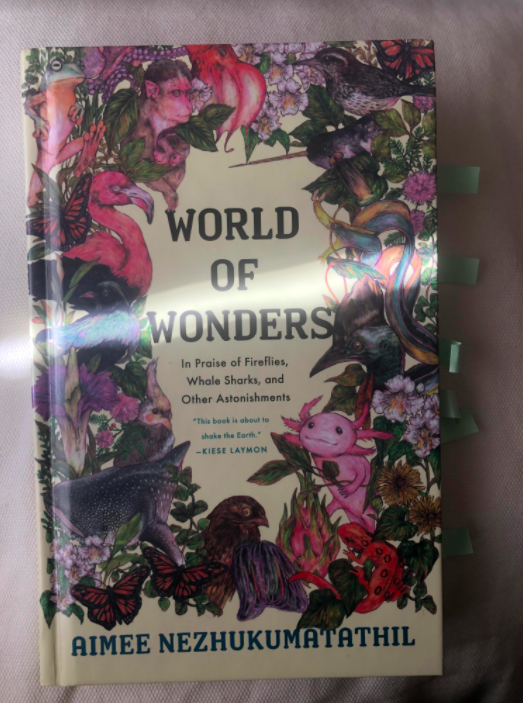A Review of Aimee Nezhukumatathil’s ‘World of Wonders’
In this time of the COVID-19 pandemic when we are often indoors, Nezhukumatathil’s writing is a breath of fresh air.
Beautiful illustrations by Fumi Nakamara draw readers in and help to bring Nezhukumatathil’s memoir to life.
Pandemic life in New York City is truly indescribable. As though out of an episode of ‘The Twilight Zone,’ the fast pace of the city that never sleeps has now dwindled to a crawl.
One would think that perhaps New Yorkers are finally relaxing – they’re too high-strung! But as time has gone on and as the days feel like they are lingering on, the itch to do things, for life to move faster, continues to pester me. How ironic – I’m stressed about not being stressed enough!
I will be completely honest. There are two reasons why I picked up World of Wonders: In Praise of Fireflies, Whale Sharks, and Other Astonishments by Aimee Nezhukumatathil. The first was that it was declared a 2020 ‘Book of the Year’ at Barnes & Noble. The second was that it has a beautiful cover, with bright illustrations of animals. I skimmed through the first few pages and decided I would give it a go. When I reached the register, the cashier took the book into her hands and looked at me meaningfully.
“Take your time with this book. Really take it all in,” she said.
I nodded with a smile, although I regarded the book quizzically. With only 165 pages, what was there to take time with? I went home that night and settled in, prepared to finish, or at least come close to the end.
From the first two chapters, engulfed under the shade of catalpa trees, surrounded by the glow of flickering fireflies, I felt the need to sit with the words that I had read. Nezhukumatathil’s beautiful poetic language begged me to slow down. For the first time in months, the itch to rush was gone.
To breeze through this book, even if well-intended, would be the equivalent of running through a field of flowers. A trail of trampled daisies precedes you, as you become more engrossed in the act of running itself than the nature around you. Did you see that honey bee climbing up the stem of that flower to your right? What about the trail of ants, marching together towards their underground abode to your left? If you do not take your time to enjoy things, then you miss the entire point of the experience.
World of Wonders is a collection of essays all revolving around the beauty of nature along with moments described in Nezhukumatathil’s personal life. Every chapter is dedicated to a different animal, plant, or natural phenomenon. Nezhukumatathil begins by describing the unique characteristics of this wonder of the Earth, such as how the Mimosa pudica plant will fold in on itself when touched, or how the narwhal has a large saber tooth at the top of its head, like the unicorn of the sea.
She then uses the rest of the chapter to relate this wonder to her own life, such as how she wishes that she could protect herself and her children from the leering stares of the outside world by folding in like the mimosa plant, or how while living away from her mother for months and enduring snide racist remarks, she managed to stick with her pod and ward off hatred with a metaphorical saber tooth.
While World of Wonders has helped me to distract myself from the drudgery of pandemic life, it is by no means escapist. It is startlingly relevant, with themes of environmental degradation, social injustice, and inequality woven into each chapter. We continue to face these issues – arguably to a greater extent than ever before – making it no wonder that the book was chosen as a 2020 Book of the Year by Barnes & Noble.
While Nezhukumatathil’s work is refreshingly personal, focusing on the challenges and beauty of growing up as a woman of color, she is also universal in her writing. Her poetic language helps readers to reflect upon the human condition and to pay more attention to the details within this fragile planet that we all share. Through Nezhukumatathil’s writing, we are all invited to step into that field of flowers and observe rather than obsess.
In such a short book, there is so much to unpack – so what does the reader walk away with when they have reached the final page? I would argue that at the heart of World of Wonders is a lesson that everyone needs to hear, to be reminded of in our socially distanced lives. We need to live with empathy, empathy for the Earth that we stand on, for the birds that fly overhead, and for each other.
While World of Wonders has helped me to distract myself from the drudgery of pandemic life, it is by no means escapist. It is startlingly relevant, with themes of environmental degradation, social injustice, and inequality woven into each chapter.
Jiada Valenza is Senior Facebook Editor and an Arts and Entertainment Editor for ‘The Science Survey,' helping to manage the newspaper's social media...

